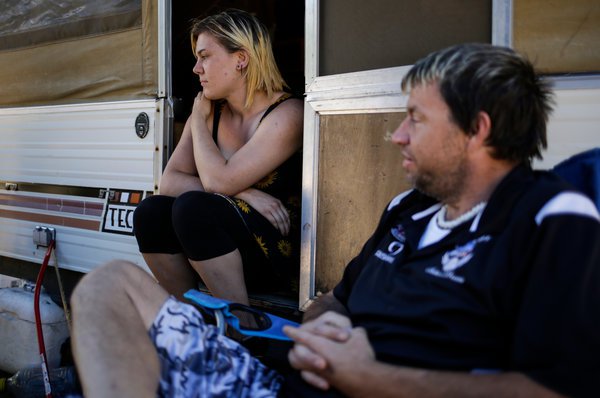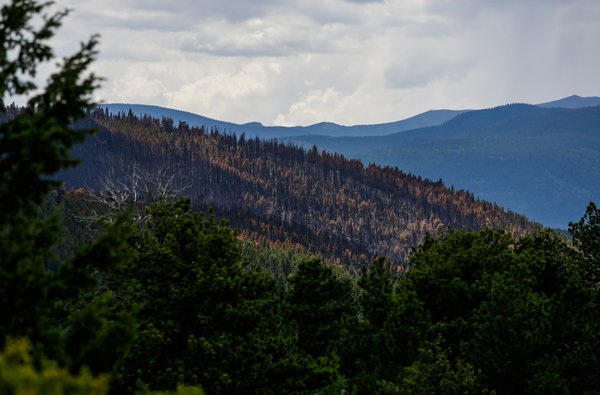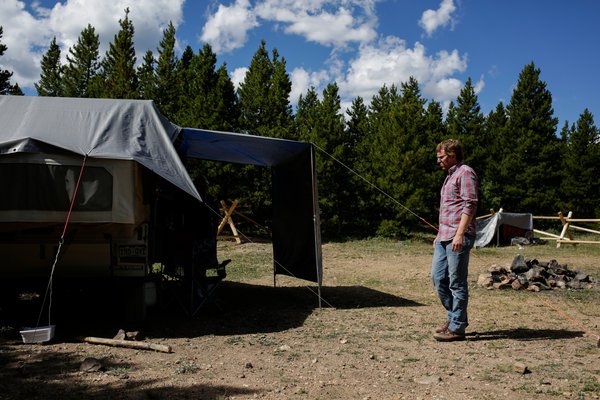As Homeless Find Refuge in Forests, ‘Anger Is Palpable’ in Nearby Towns
ANGLO AMERICA, 29 Aug 2016
Jack Healy – The New York Times
21 Aug 2016 — Gerald Babbitt lives in these woods, in a pop-up trailer on cinder blocks that he bought for $250. His toilet is a bucket, and when he and his wife need to refill their water jugs, they drive their creaky green Jeep a mile down the mountain and into town. Most people are kind, but the other day someone called them “homeless vagrant beggars,” Mr. Babbitt said.

Darcee and Gerald Babbitt at their campsite outside Nederland. “Yes, we’re homeless,” Mr. Babbitt said. “No, we’re not vagrants. No, we’re not beggars.”
Nick Cote for The New York Times
“Yes, we’re homeless,” he said, sitting in the shade of his camper here in the Arapaho National Forest. “No, we’re not vagrants. No, we’re not beggars. We just barely are making it. What you see is by the grace of God.”
To millions of adventurers and campers, America’s national forests are a boundless backyard for hiking trips, rafting, hunting and mountain biking. But for thousands of homeless people and hard-up wanderers, they have become a retreat of last resort.
Forest law enforcement officers say they are seeing more dislocated people living off the land, often driven there by drug and alcohol addiction, mental health problems, lost jobs or scarce housing in costly mountain towns. And as officers deal with more emergency calls, drug overdoses, illegal fires and trash piles deep in the woods, tensions are boiling in places like Nederland that lie on the fringes of the United States’ forests and loosely patrolled public lands.
“The anger is palpable,” said Hansen Wendlandt, the pastor at the Nederland Community Presbyterian Church.
Some residents have begun taking photographs of hitchhikers or videotaping confrontations with homeless people camping in the woods and posting them online, including on a private Facebook page created recently called Peak to Peak Forest Watch. Some say the campers have cursed at them for driving past without picking them up, or yelled at them while they were cycling or hiking. They say they no longer feel comfortable in some parts of the woods.
But as a homeless man named Julian, 30, hiked down from the hills and into Nederland one rainy afternoon, guitar and knapsack slung on his back, he said a passing driver yelled at him to get out of town. He said he, too, felt uncomfortable and was heading toward Estes Park, Colo., then on to Oregon. He did not give his last name because he said he did not want friends and family reading that he was homeless.
Mr. Wendlandt serves lunch and hands out socks to needy campers every Thursday. But he has stopped provisioning people with blankets and sleeping bags, worried that what seemed like compassion could be exacerbating a problem.

Charred trees outside Nederland, Colo., after a wildfire burned 600 acres in July. Two transient men were charged with starting the blaze when a campfire was not fully extinguished.
Nick Cote for The New York Times
A wildfire in July was a tipping point. Two men from Alabama pitched camp without permission on a privately owned hillside near Nederland, lit a campfire and read their Bibles, they told the Boulder County Sheriff’s Office. The men told officials they put some rocks on the fire to put it out, and though they discussed whether they should do more to smother it, they decided not to.
One smoldering cigarette or lightning strike can ignite an entire hillside in the parched, fuel-filled forests across the West, and officials say the campfire galloped away and burned 600 acres of canyons and forests around Nederland. It destroyed eight homes, including that of a fire captain.
The two men who started the campfire, Jimmy Suggs and Zackary Kuykendall, were arrested and charged with fourth-degree arson. The day before their arrest on July 10, the two men and a female companion — who was not criminally charged — happened across a reporter for The Boulder Daily Camera who was interviewing evacuees from the still-burning fire.
“We were pretty close,” Mr. Suggs told the newspaper. “It looked like the whole mountain range was on fire.”
Citing the fire danger, some residents have asked the Forest Service to do what many cities have done in cracking down on the homeless: impose tighter rules on camping, or ban it in parts of the woods that have attracted the most people.
The Forest Service says it is working with thin law enforcement resources. One officer is assigned to Boulder County, which encompasses Nederland and the Roosevelt and Arapaho National Forests, which dominate the western part of the county. The service is spending more and more of its budget fighting wildfires, and has pared back on filling some law enforcement posts, said Chris Boehm, the agency’s acting deputy director for law enforcement and investigations.
“There may be some regions where we have one officer assigned to an entire forest or area,” he said. “That’s not what we want, but fires are expensive.”
The Nederland fire was one of a handful across the West in recent years that officials have blamed on transient campers. In Anchorage this May, officials said a two-acre brush fire appeared to start in a homeless camp. In Northern Arizona, where a homeless man was sentenced to a year in prison in 2010 for accidentally igniting a 280-acre wildfire, officials stepped up patrols this summer to look for illegal fires set by people living in the woods.

Hansen Wendlandt, the pastor at the Nederland Community Presbyterian Church, runs an outreach program for homeless people in the area.
Nick Cote for The New York Times
For years, people searching for solitude or without better options have retreated to live in the woods, in buses, vans, tents or other improvised shelters, their numbers swelling every summer and dwindling when the snow comes. But officials say public lands researchers are just beginning to study who lives there, and why.
A 2015 survey of 290 law enforcement officers for the Forest Service found that officers in the Rocky Mountain West and Southwest encountered long-term campers most often. About half of the officers said the number of these long-term campers was on the rise, and only 2 percent said it had declined. (The rest said the number had either largely held steady or fluctuated.)
Lee Cerveny, one of the researchers who conducted the survey, said it was unclear how many people might be living on public lands at any given time.
“What is happening, and why are we seeing more people living in the forests?” she said. “We don’t know yet.”
National parks place strict limits on camping, but in national forests and open spaces managed by the Bureau of Land Management, people can pitch tents just about anywhere camping is not prohibited. Many forests allow camping for only two weeks at a time. In 2015, the Forest Service handled 1,014 episodes related to violations of those rules.
Around Nederland, crime reports, medical emergencies, unattended fires and other calls for help and extra patrols have soared at three Forest Service areas popular with homeless campers. The Boulder County Sheriff’s Office was called there 388 times last year, up from 213 in 2013, and officials attribute some of the rise to Colorado’s reputation as a mecca for legal marijuana, and Nederland’s embrace of retail marijuana dispensaries.
Rick Dirr, the Nederland fire chief, said his largely volunteer firefighters no longer answer nighttime calls in the woods without a marshal or sheriff’s officer as backup. He said he has faced down one camper who carried a butcher knife, and searched the woods for another man who had attacked his girlfriend. There was the boy who swallowed a heroin baggie, he recalled, and a man who was hit in the head with a shovel.
Others just do not understand how the forest works, he said. He responded to a report of an illegal fire to find a teenage boy and his 8-year-old sister alone at their campsite, bags of garbage everywhere. They and their parents had been living out of their car, and the father asked Chief Dirr when someone would come by for garbage pickup.
“We still don’t have a solution,” he said. “These are the things going on unseen in the woods.”
DISCLAIMER: The statements, views and opinions expressed in pieces republished here are solely those of the authors and do not necessarily represent those of TMS. In accordance with title 17 U.S.C. section 107, this material is distributed without profit to those who have expressed a prior interest in receiving the included information for research and educational purposes. TMS has no affiliation whatsoever with the originator of this article nor is TMS endorsed or sponsored by the originator. “GO TO ORIGINAL” links are provided as a convenience to our readers and allow for verification of authenticity. However, as originating pages are often updated by their originating host sites, the versions posted may not match the versions our readers view when clicking the “GO TO ORIGINAL” links. This site contains copyrighted material the use of which has not always been specifically authorized by the copyright owner. We are making such material available in our efforts to advance understanding of environmental, political, human rights, economic, democracy, scientific, and social justice issues, etc. We believe this constitutes a ‘fair use’ of any such copyrighted material as provided for in section 107 of the US Copyright Law. In accordance with Title 17 U.S.C. Section 107, the material on this site is distributed without profit to those who have expressed a prior interest in receiving the included information for research and educational purposes. For more information go to: http://www.law.cornell.edu/uscode/17/107.shtml. If you wish to use copyrighted material from this site for purposes of your own that go beyond ‘fair use’, you must obtain permission from the copyright owner.